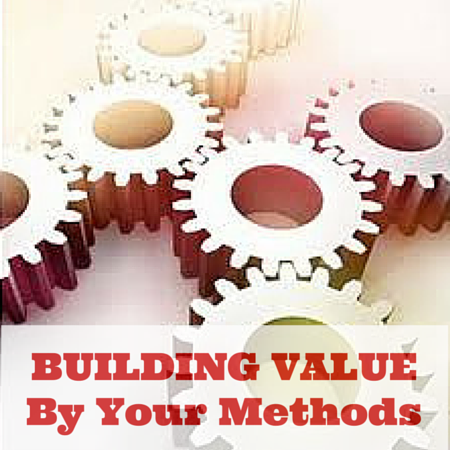Building Value With Unique Methods
Unique Methods is a concept that I learned from The Strategic Coach, Dan Sullivan. Everyone has processes that are unique to them. No two people go about design exactly the same, for instance. There are three main benefits to identifying your unique methods.
Once a process is on paper, it can be delegated or taught, freeing you to do other things or getting help doing this thing.
The exercise of documenting your process often leads to improvements in the process.
The more of your processes that you can standardize, the less time is spent re-inventing the wheel on each project.
Taken together these three benefits add value to your firm by making your successes repeatable on every project.
Avoiding the E-Myth Trap and Building a Valuable Firm
Working on your firm in this way is the main activity that is necessary to avoid the E-Myth Trap - thinking that because you are good at something then your own firm will be a success. Tens of thousands of architectural firms struggle with this trap. I was one of them.
I wanted to build a firm of value that would survive me. But I didn't know how. Most of us know so little about business, that it takes decades before we see the light. If our firms are to grow and endure then be have to endow them with the experience that we gain. We do that by documenting what works so that anyone in the firm can learn how to repeat our successes. This is a topic I have touched on HERE if you want to dig deeper.
So how do you go about documenting your Unique Methods?
You can choose to do this solo, or you can get a team together and tackle the project together. There is no end to what you can think through this way. To give you an idea, here are some of the processes in my firm that we documented.
Writing specifications
Key steps of every phase of design services
Reimbursable Expenses process (we were leaving over $10,000 per year un-billed)
Invoicing process (we got invoices out two business days after the end of the month)
File naming convention
Standardized information location
Typical deliverables per phase
Typical tasks for each phase of service
Bidding process
In quite a few of these instances we used the form below to document the final result. During the thinking stage of the proces we found that sticky notes on the wall let us see the process better and make changes very simply.
Not everyone is 'wired' to look for ways to improve a process. Some people like tackling a task differently every time it comes around. But even the act of designing is a candidate in spite of every design problem being unique. Recognizing your unique method of doing anything can make doing it a smoother process. Here's an example of what I mean.
I like to start a design problem with context, understanding the present situation, taking note of the surroundings. Context tells me what "kind" of solution the problem "wants". From there I often look at constraints next - zoning, codes, approvals needed. I want to know where the danger zones are, where I might waste time looking for solutions that will never be "clean". You can see that my overall approach is about elimination. I am much more comfortable knowing up front where the boundaries are. 'Infinite possibilities' is not reality for me. There are always boatloads of solutions that won't work well. I like to get rid of them up front.
So I documented that process as a Unique Method. Every time I start thinking about a new project, out comes my process diagram to remind me how to proceed effectively. Having this tool lets me delegate some of the research and data-gathering so that my time is used on the important things.
Everything you do is a candidate for becoming a Unique Method. Work on your business development process, for instance. Having it outlined on paper means that you can study what is working/not working. Lots of business development tasks can be done by just about anyone. That lets you do more business development. Doing more business development leads to more business. That seems worthwhile to me.
Consider getting everyone involved in the process. Anything that is going well is a candidate; not just the stuff you do. This could be any part of the project process. Break it down and document what is worth repeating.
Things that aren't working well are good candidates, too. Record keeping might be a mess. Think about what it would take to get it under control. Or maybe cost estimates aren't tight enough. What about thorough code research?
The opportunities are endless. Make a start. Document one thing a month - or more if you can. But the point is that before six months have passed, you will already be a better firm. Your firm's value to you and to your clients will keep on growing.
It isn't magic, it is just one foot in front of the other.

